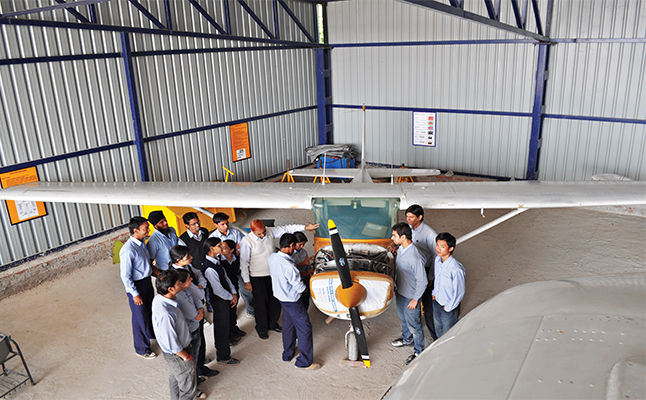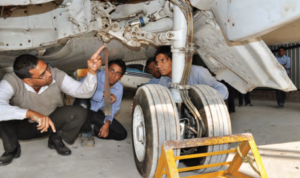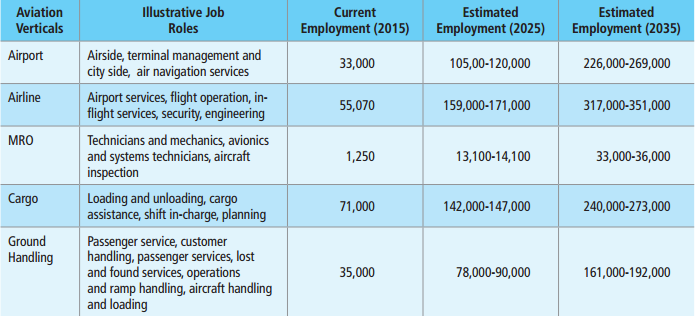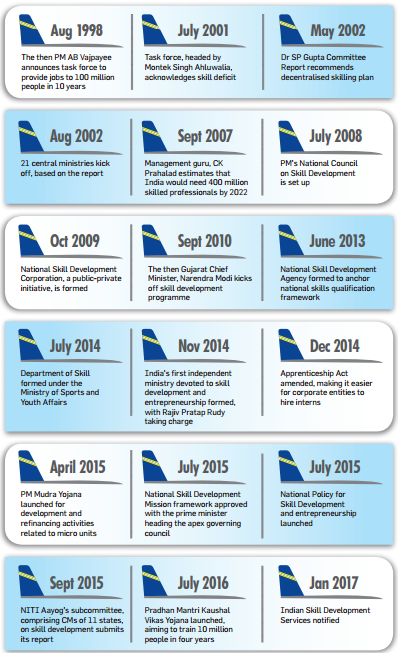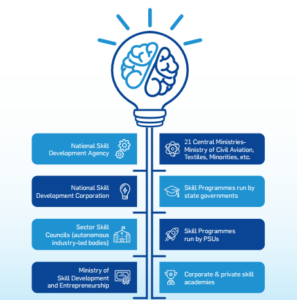Skill Development
AIBM
April - June 2017
As the fastest growing aviation market, India embarks on an ambitious plan to spot, skill and shape its emerging workforce to keep up the momentum.
Prime Minister Narendra Modi has set an ambitious agenda to transform India into a global manufacturing hub. To achieve this goal, several initiatives are being taken to encourage both multinational as well as domestic companies to manufacture their products within the country. Working towards the goal, India seeks to facilitate job creation, foster innovation, enhance skill development and protect intellectual property.
Tapping Demographic Dividends
India’s already huge population is expected to further inflate to around 1.4 billion by 2025. The population pyramid is expected to bulge across the 15–64 age bracket over the next decade, increasing the working age population from approximately 761 million to 869 million during 2011–2020.
Consequently, until 2020, India will be experiencing a period of ‘demographic bonuses’, where the growth rate of the working age population would exceed that of the total population. With a youthful demography, India will produce 10-12 million job seekers every year.
Only a fraction of them are estimated to be readily employable with skills following some training, compared to the well-trained job seekers in the developed economies, such as Japan, South Korea and Germany.
Spot, Skill and Shape
To address the issue of skill deficit, India, for more than a decade now, has engaged with various stakeholders beginning with the then Prime Minister, Atal Bihari Vajpayee, who set up a task force to provide for 10 million jobs annually for 10 years in 2001. Since then, India has taken several initiatives to spot, skill and shape its emerging workforce.
Prime Minister Narendra Modi has also launched the Skill India programme to offer vocational training to roughly 400 million people by 2022. The new ministry of skill development and entrepreneurship, under the stewardship of Rajiv Pratap Rudy, is addressing the humongous challenge of scaling up disparate skill development initiatives of all the stakeholders.
These include massive budgetary allocation for skill development programmes, convergence of various training programmes, creation of a labour pool for industrial needs, setting up of finishing schools to polish the skills of the workforce and the skill-poor rural youth under the ‘Deen Dayal Upadhyaya Grameen Kaushalya Yojana’, and synergising of skill implementation effort.
Robust Aviation Market
At a time when the Skill India mission is fraught with challenges across sectors, the aviation sector in India has emerged as the fastest growing market. According to the International Air Transport Association (IATA), the country has been the world’s fastest growing domestic air market for 22 months in a row.
“India led domestic air markets in year-on-year growth for the 22nd month in a row. January traffic soared by 26.6 pc, marking the 15th consecutive month of over 20 pc annual growth. Demand is being stimulated by strong flight frequency. Globally, domestic air travel climbed by 9.9 pc in January, year-on-year,” the report has stated.
Now, India is all set to provide financial assistance to boost airline travel between smaller cities. India launched the Regional Connectivity Scheme (RCS) to get more people to fly in what is already the world’s fastest-growing aviation market. Under the scheme, the government has capped fares and is offering incentives to attract airlines to fly less-traversed routes. With a growing population and increasing propensity to travel, the nation’s civil aviation industry is witnessing a high growth trajectory. India is expected to become the third largest aviation market by 2020 and the largest by 2030.
Indian Aviation Sector Requirements
Comprehensive Benefit
A study by ICRA Management Consulting Services Limited (IMaCS) last year estimated that by 2035, the Indian civil aviation sector will employ millions of personnel directly and indirectly. Appointed by the Ministry of Civil Aviation (MoCA), to conduct a comprehensive skill gap analysis and formulate a road map for skill development initiatives for the civil aviation sector in India, the IMaCS report asserted, “Our estimate indicates that by 2035, the Indian civil aviation sector [across the study segments of airports, airlines, cargo, MRO (maintenance, repair and overhaul) and ground handling] will employ 0.8-1.0 million personnel directly and another three million indirectly (for one direct job about 3.5 indirect jobs are created).”
Other key recommendations include the setting up of the National Civil Aviation Training Authority and the Cargo and Ground Handling Sector Skill Council.
Driving Skill Drills
As aviation remains no longer a prerogative of the rich, several stakeholders are realising the immense opportunity the sector provides, and beginning to undertake skilling initiatives. “With the unprecedented growth in the Indian aviation sector, all stakeholders have supported skill development at a war footing,” observes Amber Dubey, partner and India head of aerospace and defence at the global consultancy, KPMG.
Leading the charge in this is the Aerospace and Aviation Sector Skill Council (AASSC), headed by T Suvarna Raju, chairman, Hindustan Aeronautics Limited, with D Peter Immanuel as the chief executive officer. AASSC had identified 70 job roles for development and formulation of the National Occupational Standards (NOS) and Qualification Packs.
The promoters of the company are Hindustan Aeronautics Limited (HAL), Bangalore Chamber of Industries and Commerce (BCIC) and Society of Indian Aerospace Technologies and Industries (SIATI). The Governing Council of AASSC has representation from the top management of the promoter organisations — government agencies, such as the Airports Authority of India (AAI) and the Ministry of Civil Aviation, leading airline companies, research organisations, vocational training providers and NSDC, Small and Medium Enterprises (SMEs).
Currently, the council is engaged in preparing the occupation map, the National Occupational Standards and Qualification Framework for Aerospace Design and Development, Aerospace Manufacturing and Assembly, Airline Operations, Airport Operations, Cargo and Ground Handling and Maintenance Repair and Overhaul (MRO).
The council, in an ambitious plan, is readying to certify around 520,000 trainees and groom 6,000 trainers over a period of 10 years in the aerospace sector.
The study has not only identified key verticals in the aviation sector, as well as illustrative jobs, but has also estimated the demand for skilled personnel by 2035.
Scaling up Skilling
Another important stakeholder is the AAI, which is responsible for creating, upgrading, maintaining and managing civil aviation infrastructure in the country. Currently, AAI manages a total of 125 airports, including 18 international airports, seven custom airports, 78 domestic airports and 26 civil enclaves at military airfields among other infrastructure and installations.
AAI has established the National Institute of Aviation Training and Management (NIATAM) at Gondia in Maharashtra. The executives of AAI are trained ‘ab initio’ and subsequently trained in advanced as well as refresher courses as part of continual training and skill upgradation. AAI has also established a CHQ training centre at New Delhi, regional training centres (RTCs) at Mumbai, New Delhi, Kolkata, Chennai and Guwahati and ‘in situ’ training centres at major airports. AAI has signed a MoU with Aviation Strategies International (ASI), which is partnering with ICAO and Airports Council International (ACI) to impart the Airport Management Professional Accreditation Programme (AMPAP), which is globally recognised, for greater cooperation in aviation-related competency and skill building.
AAI entered into a joint venture with the Bureau of Civil Aviation Security (BCAS) and formed a new autonomous body – the National Institute of Aviation Management and Research (NIAMAR) Society – to augment the training activities in the civil aviation sector and also to impart knowledge to other stakeholders. The Indian Aviation Academy (IAA) has been established under this society, aiming to develop itself as a centre of excellence in the area of education, training and research in aviation in the Asia Pacific region.
Furthermore, AAI has recently engaged McKinsey, to review its organisational structure and address capability building and training programmes.
Institutional Framework
Besides mandating corporate entities to spend 2 pc of their profits on corporate social responsibility (CSR), the government has evolved half a dozen models for corporate houses to participate in reducing skill gap across different sectors of the Indian economy. These include leveraging unused infrastructure in public and private sectors for imparting skills, setting up Greenfield and Brownfield centres and establishing trade specialisation labs in existing centres, donating high-cost equipment, certifying contract workers through formal skill certification process and donating CSR funds to the National Skill Development Fund. The response from the stakeholders has been impressive thus far.
Global Tie-ups
Not willing to miss the huge business opportunities that the nation offers as the fastest global economic engine, several global aviation MNCs have turned their attention to India and have expressed eagerness to be part of the skill drive. “In the form of a partnership with Airbus and Boeing, we will be launching a finishing school. We will have a one-year-long course, where diploma holders can seek an entrance, get training and enhance their employability,” Minister of State for Civil Aviation, Jayant Sinha, said during an industry engagement.
In February, Airbus signed a MoU to establish a Centre of Excellence for aerospace skill development in Hyderabad, together with the Government of Telangana, National Skill Development Corporation, India and AEROCAMPUS, France, which will offer short-term refresher modules as well as longterm certificate and diploma courses, which will find acceptability within the industry.
In March, US aviation MNC, Boeing — which designs, manufactures and sells airplanes, rotorcraft, rockets and satellites worldwide — along with Tata Advanced Materials Limited (TAML) and Nettur Technical Training Foundation (NTTF) had announced the launch of a skills development programme to train front-line workers for the aerospace industry.
Besides Airbus and Boeing, the ministry is mulling over opening seven or eight such centres across the country, which Sinha observed would help plug the gaps in the skill development chain.
All these efforts are just the beginning, as India is on the cusp of a massive change. It is firing on all cylinders to skill the youth force, create employment, attract foreign direct investments, transform India into a global manufacturing hub and boost the aviation sector. On the anvil is India’s future, which looks bright, to say the least.

